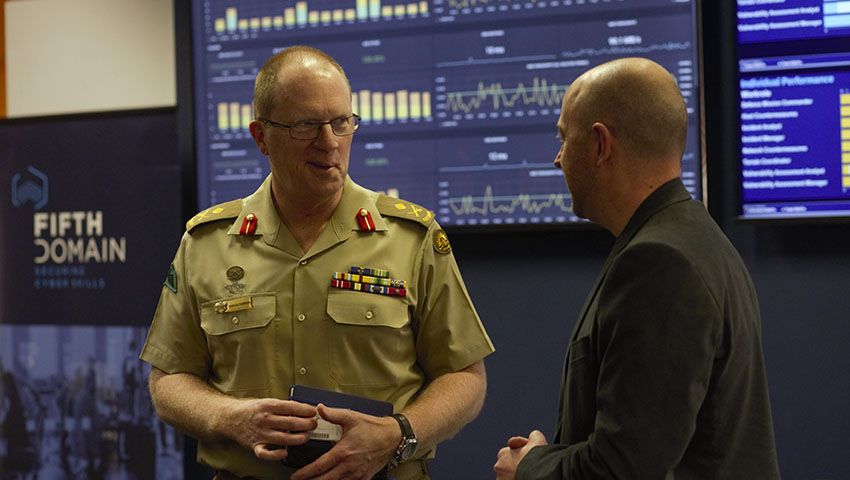Information is often described as the ‘oil of the 21st century’ and is a key enabler for civilians, businesses, government and militaries. Staying ahead of the curve and guaranteeing information supremacy is critical to the success of the ADF.
To continue reading the rest of this article, please log in.
Create free account to get unlimited news articles and more!
Across the ADF, transformation, evolution and digitisation are at the centre of the development and modernisation of the Army, Navy and Air Force.
At the core of this process, beyond the next-generation mega platforms like the Army’s new fleet of Boxer combat reconnaissance vehicles, man-portable unmanned aerial systems and integrated air defence capabilities, Navy’s Hobart Class air warfare destroyers and future frigates, and Air Force’s F-35 Joint Strike Fighter, is one key component: information.
Meanwhile, net operating concepts like ‘Accelerated Warfare’, Plan Pelorus 2022 and Air Force Strategy 2020, Plan Jericho and the development of a ‘Fifth-Generation Air Force’ all depend on the ADF and an allied capacity to gather, analyse and disseminate information from a range of inputs to inform decision-makers.
The scope of information sources, from traditional human intelligence (HUMINT), electronic and signals intelligence (ELINT and SIGINT, respectively), and increasingly the interconnected, digitised world of cyber space are all critical components of the next-generation ADF.
In this issue of On Point, Defence Connect speaks to the Australian Defence Force's Head of Information Warfare Division, Major General Marcus Thompson, AM, to discuss the power of information in this new era of conflict.
Defence Connect: For those who don’t know the history of the Information Warfare Division, could you give us a little background about the IWD and how it fits within the ADF?
MAJGEN Thompson: The Information Warfare Division was created in July 2017.
It came about as a result of a key recommendation from the first principles review that your [readers] might recall from 2015. And the observation was that defence hadn't paid appropriate attention to some of these capabilities that don't necessarily neatly fit within the Navy, the Army or the Air Force.
A lot of people would know them as glue capabilities, these are the essential combat functions that tie joint combat functions together.
Building on that, the observations related to emerging capabilities, such as cyber and electronic warfare and the proliferation of IP-based technology, the command and control systems, and of course how that all fits into intelligence, information operations, and other capabilities.
Our work is not operational, so to speak. The actual operations piece tends to be the responsibility of the Chief of Joint Operations, and of course the Australian Signals Directorate, including the Australian Cyber Security Centre.
Our role within Information Warfare Division is to develop and manage the capabilities that those people use on a day-to-day basis, on an as-required basis.
Defence Connect: How does Information Warfare support and protect the ‘digitisation’ of the ADF and its next-generation of capabilities and platforms?
MAJGEN Thompson: There’s billions of dollars of taxpayer investment in modernising the Australian Defence Force over the next couple of decades.
All of these new platforms are digital. The Air Warfare Destroyer, the Joint Strike Fighter, and the vehicles that will be acquired under Army's LAND 400 program will be digital platforms.
They are extensions of the network within the Australian Defence Force. The conversation around cybersecurity very quickly extends beyond a traditional view of computer networks to combat systems.
I am always at great pains to talk about networks and mission systems because, in this digital combat platform, the first thing that's going to happen when that ship pulls alongside, when that aircraft is towed into a hanger, or that vehicle pulls into a workshop, is that someone is going to plug in an electronic device.
I want to know where that device has been. Who's responsible for its hygiene. Is it a contractor who's using it?
Is it a Commonwealth official who's plugging it in? Was that device used with the free Wi-Fi at a restaurant for breakfast while the person was having breakfast that morning?
These are all the things that the entire Defence Force is now thinking about because those combat platforms, if they've got to be used, the operator needs confidence that it will perform to spec.
Defence Connect: How do you balance that strategisation of cyber and digital connectivity within the ADF?
MAJGEN Thompson: We know that there is a new piece of malware on the streets every 12 seconds, which is forecast to drop to every seven seconds over the next couple of years.
It is a real challenge to be casting forward with defence acquisition timelines and saying, "Well, what might the environment look like in three to five years’ time?" Let alone, say, 20 to 30 years’ time for some of the larger programs.
I don't know what the threat is going to be doing in three months’ time, let alone in three years’ time.
It is a constant challenge and what we've done, quite deliberately, is left some of these requirements and some of these descriptions fairly broad.
This means that we're not tying ourselves to something that might very quickly become irrelevant or be superseded by technology or, indeed, by the emergence of a particular threat.
You can listen to the full Insight podcast with Major General Marcus Thompson here.

 Login
Login







